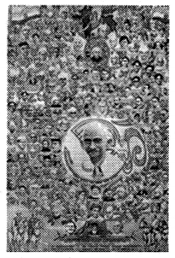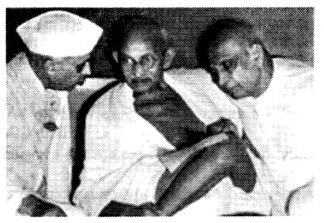Do you need some help in preparing for your upcoming Class 12 History exam? We’ve compiled a list of MCQ questions on Mahatma Gandhi and the Nationalist Movement Class 12 MCQs Questions with Answers to get you started with the subject. You can download NCERT MCQ Questions for Chapter 13 Mahatma Gandhi and the Nationalist Movement: Civil Disobedience and Beyond with Answers Pdf free download, and learn how smart students prepare well ahead MCQ Questions for Class 12 History with Answers. Start your preparation with MCQ on Mahatma Gandhi and the Nationalist Movement Class 12 Objective Questions.
Mahatma Gandhi and the Nationalist Movement Class 12 MCQs Questions with Answers
Question 1.
Which of the following statements regarding Mahatma Gandhi is/are correct?
(i) He attended the Second Round Table Conference.
(ii) He opposed the demand for separate electorates for lower castes.
(iii) He returned to India in 1917 after two decades.
(iv) He acknowledged Lala Lajpat Rai as his political mentor.
Choose the correct option.
(a) Only ii
(b) ii and iv
(c) iii and iv
(d) i and ii
Answer
Answer: (d) i and ii
Question 2.
When did Mahatma Gandhi make his major public appearance?
(a) 1915
(b) 1916
(c) 1917
(d) 1918
Answer
Answer: (b) 1916
Question 3.
A series of ‘Praja Mandals’ was established to promote nationalist creed in
(a) Middle classes
(b) Princely states
(c) Merchant community
(d) All of the above
Answer
Answer: (b) Princely states
Question 4.
In which year was the First Round Table Conference held?
(a) 1928
(b) 1929
(c) 1930
(b) 1931
Answer
Answer: (c) 1930
Question 5.
Which of the following was the first mass movement against the British in India?
(a) Quit India Movement
(b) Khilafat Movement
(c) Civil Disobedience Movement
(d) Swadeshi Movement
Answer
Answer: (d) Swadeshi Movement
Question 6.
In which year did Mahatma Gandhi give a call for the Quit India movement?
(a) 1930
(b) 1936
(c) 1942
(d) 1945
Answer
Answer: (c) 1942
Question 7.
Who led the Khilafat Movement in India?
(a) Muhammad Ali and Shaukat Ali
(b) Mohammad Ali Jinnah and Shamsuddin Hussain
(c) Maulana Azad and Hasrat AAohini
(d) Qutubuddin Ahmad and Maulana Azad
Answer
Answer: (a) Muhammad Ali and Shaukat Ali
Question 8.
Who called for the ‘Direct Action Day’ hartal?
(a) Mahatma Gandhi
(b) Mohammad Ali Jinnah
(c) Jawaharlal Nehru
(d) Sardar Vallabh Bhai Patel
Answer
Answer: (b) Mohammad Ali Jinnah
Question 9.
In which year did the Muslim League pass a resolution for a separate nation Pakistan?
(a) 1940
(b) 1942
(c) 1944
(d) 1945
Answer
Answer: (a) 1940
Question 10.
Where was Gandhi’s Ashram located?
(a) Dandi
(b) Champaran
(c) Kheda
(d) Sabarmati
Answer
Answer: (d) Sabarmati
Question 11.
Explain one point of difference between the Civil disobedience Movement and the Non-Cooperation Movement.
Answer
Answer: In the Non-Cooperation Movement people were asked not to cooperate with the British government in any way. On the other hand, the Civil Disobedience Movement asked the people to break colonial laws and not to pay taxes to the government.
Question 12.
In which year did Mohandas Karamchand Gandhi return to his homeland?
Answer
Answer: In January 1915, Mohandas Karamchand Gandhi returned to his homeland.
Question 13.
The ________ was a movement of Indian Muslims, led by Muhammad Ali and Shaukat Ali.
Answer
Answer: Khilafat Movement
Question 14.
What does this picture depict?

Answer
Answer: In this picture within the tree of nationalism, Mahatma Gandhi is shown as the central figure surrounded by small pictures of other leaders and sages.
Question 15.
Nehru edited a collection of letters written to him during the national movement and published ________
Answer
Answer: A Bunch of Old Letters
Question 16.
Identify and name the personalities shown in the picture.

Answer
Answer: Personalities shown in the picture are Jawaharlal Nehru, Mahatma Gandhi, and Vallabh Bhai Patel.
Question 17.
Indicate which of the following statements is NOT correct.
(a) Quit India was genuinely a mass movement.
(b) The Simon Commission was opposed as it had all British members.
(c) In its session held in 1930 in Lahore, the Indian National Congress passed a resolution for the complete independence of India.
(d) On the 16th of August, 1946, the Muslim League called for a “Direct Action Day”.
Answer
Answer: (c) In its session held in 1930 in Lahore, the Indian National Congress passed a resolution for the complete independence of India.
Question 18.
Arrange the following events of the National Movement in chronological order:
1. Gandhi-Irwin Pact
2. Champaran Movement
3. Mahatma Gandhi visits Noakhali
4. Peasant Movement in Bardoli Choose the correct option:
(a) 1, 3, 4 and 2
(b) 2, 4, 1 and 3
(c) 1, 4, 3 and 2
(d) 4, 1, 2 and 3
Answer
Answer: (b) 2, 4, 1 and 3
Question 19.
Read the information given below:
| This Act authorised the Government to imprison any person without trial and convict him in court. It was considered as ‘Black Law’ by all Indians. |
Identify and name the Act passed by the British.
Answer
Answer: RowlattAct
Question 20.
Match the following.
| (i) Jallianwala Massacre | (a) 1918 |
| (ii) Peasant movement in Kheda | (b) April 1919 |
| (iii) Second Round Table conference | (c) 1939 |
| (iv) Second World War started | (d) 1931 |
Choose the correct option.
(a) i – c, ii – d, iii – a, iv – b
(b) i – a, ii – b, iii – d, iv – c
(c) i – b, ii – a, iii – d, iv – c
(d) i – d, ii – a, iii – b, iv – c
Answer
Answer: (c) i – b, ii – a, iii – d, iv – c
Question 21.
Consider the follow g statements regarding the events of the National Movement.
(i) On 12 March 1930, Gandhiji began his march from Sabarmati Ashram towards Dandi.
(ii) In 1919, Gandhiji called for a countrywide campaign against the Rowlatt Act.
(iii) After the failure of the Cabinet Mission, Mahatma Gandhi decided to launch Quit India Movement.
Which of the following statement (s) is/are correct?
(a) I and II
(b) II and III
(c) I and III
(d) II only
Answer
Answer: (a) I and II
Question 22.
Given below are two statements, one labelled as Assertion (A) and the other labelled as Reason (R):
Assertion (A): We need to be careful while interpreting government reports of the colonial period.
Reason (R): They often reflect the fears and anxieties of officials who were unable to control a movement and were anxious about its spread.
(a) Both (A) and (R) are correct and (R) is the correct explanation of (A).
(b) Both (A) and (R) are correct and (R) is not the correct explanation of (A).
(c) (A) is correct but (R) is not correct.
(d) (R) is correct but (A) is not correct.
Answer
Answer: (a) Both (A) and (R) are correct and (R) is the correct explanation of (A).
We hope you found this CBSE Class 12 History Mahatma Gandhi and the Nationalist Movement MCQs Multiple Choice Questions with Answers helpful. If you have any questions about NCERT MCQ Questions for Class 12 History Chapter 13 Mahatma Gandhi and the Nationalist Movement: Civil Disobedience and Beyond with Answers Pdf free download, please share them in the comment box below and we will get back to you at the earliest possible time.